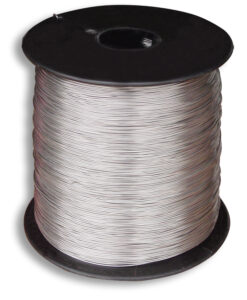Inconel Wire and Stainless Steel: 2 Similar Materials With Different Applications
The Difference Between Inconel Wire and Stainless Steel
Wire has a wide range of applications across industries. However, not all wire is created equal. When selecting a wire for use, it’s important to consider facets like heat resistance, tensile strength, price, and corrosive resistance. The needs for certain specifications can vary from industry to industry. Below we’ll cover two different materials, their benefits, and why you might choose them for certain applications.
Inconel Wire
Inconel is considered a superalloy due to its corrosion resistance and suitability for environments with extreme pressures and temperatures. The tensile strength range of Inconel is 103 – 160 ksi (kilopounds per square inch), compared to 73.2 ksi for stainless steel, and it can maintain this strength at higher temperatures. However, despite this strength disparity, sterile manufacturing environments and medical applications will likely prefer stainless steel alloys. Heat-treating and other high-temperature processes are better suited to superalloys like Inconel. During the heat treating process, it is not uncommon for Inconel wires to be used to hold parts together. Due to their high weight resistance and heat resistance, they won’t dissipate during the process, and parts will remain secure.
According to reported statistics, the melting point of Inconel ranges between 2,350°F and 2,460°F (1,290°C and 1,350°C). In spite of Inconel’s lower melting point than stainless steel, Inconel 625® is stronger at high temperatures and more resistant to oxidation and scaling than stainless steel.
Due to this heat resistance, a great application for Inconel wire would be serving as safety wire in jet and engine applications. Jet engines can get very hot, and having a resilient material like inconel can be all the difference in the safety wire failing or working. When the engines get, hot Inconel safety wires are reliable to hold strong and keep everything in place.
Due to its extreme heat resistance, Inconel wire is used in industries such as aerospace, oil & gas, and welding, and more. Inconel wire can withstand heat up to 2460 degrees Fahrenheit and is renowned for its strength and durability.
Stainless Steel Wire
Stainless steel wire is another popular and efficient form of wire. As mentioned above it is also has high tensile strength, and while it is less heat resistant than inconel, it does still maintain a good degree of resistance.
 Along with resisting heat, stainless steel also resists corrosion very well, which makes it a great material for sterile environments. One specific use for stainless steel wire in the medical field is usage in catheters.
Along with resisting heat, stainless steel also resists corrosion very well, which makes it a great material for sterile environments. One specific use for stainless steel wire in the medical field is usage in catheters.
Stainless steel wire is also used as safety wire. Stainless steel is of course suitable for situations of lower heat and stress, but can still be just as effective in the right scenario. Stainless steel shares a common strength with inconel wire in that it is highly corrosive resistant. The corrosion resistance of stainless steel is due to its chromium content, which forms a passive layer that protects the underlying material from attack and can self-heal when exposed to oxygen.
This resistance to corrosion and rust is an absolute necessity in industries like the medical field. The sterile nature of the environment is crucial to painting people’s health and keeping things from going awry. It is not often wire is used in the medical field, but other utensils and tools are often made of stainless steel for the sake of sustainability.


